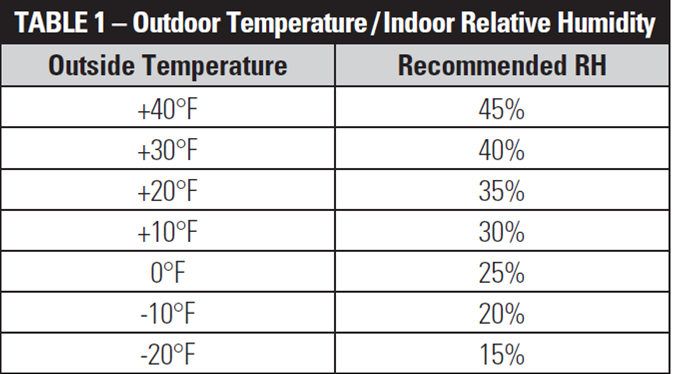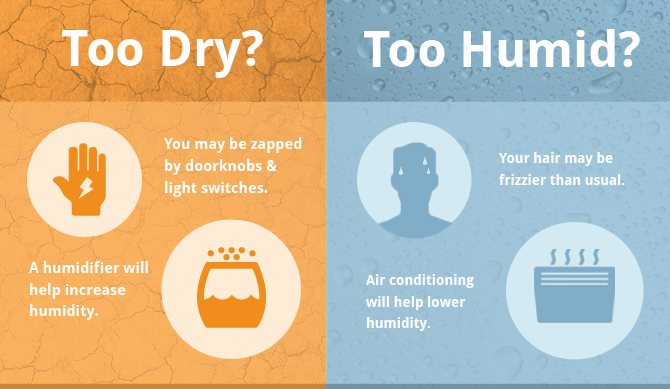What Should The Humidity In The House Be

Maintaining optimal humidity levels within your home is crucial for comfort, health, and the longevity of your building's structure. But what exactly *should* the humidity in your house be? The answer, while seemingly simple, involves several factors, including the season, your geographic location, and even your personal preferences.
Understanding Relative Humidity
The term most often used when discussing indoor humidity is relative humidity (RH). Relative humidity is the amount of moisture in the air compared to the maximum amount of moisture the air can hold at a specific temperature. This is expressed as a percentage. For example, 50% RH means the air is holding half the moisture it's capable of holding at that temperature.
Why does temperature matter? Warmer air can hold more moisture than colder air. This is why humidity often feels higher in the summer, even if the actual amount of moisture in the air hasn't changed drastically. A cold room with 60% RH might feel less humid than a warm room with the same RH.
The Ideal Humidity Range: A Year-Round Guide
Generally, the ideal relative humidity for your home falls within the range of 30% to 50%. However, this range can vary depending on the season.
Summer Humidity
During the summer months, aim for the lower end of the range, ideally between 30% and 40% RH. High humidity in the summer can lead to several problems:
- Discomfort: High humidity makes it harder for your body to cool itself through perspiration. This leads to that sticky, uncomfortable feeling.
- Mold and Mildew Growth: Excess moisture provides the perfect breeding ground for mold and mildew, which can damage your home and trigger allergies.
- Increased Pest Activity: Many pests, like dust mites and cockroaches, thrive in humid environments.
To control humidity in the summer, use your air conditioner. Air conditioners not only cool the air but also remove moisture. If your AC isn't keeping up, consider a dehumidifier, especially in basements or other areas prone to dampness.
Winter Humidity
In the winter, you might need to adjust your humidity targets downward. Aim for between 30% and 40% RH, and even lower if you live in a particularly cold climate. Maintaining too high a humidity level in the winter can lead to condensation on windows and other cold surfaces, which can then lead to mold growth and structural damage.
Extremely low humidity, on the other hand, can also be problematic. It can cause:
- Dry Skin and Irritated Airways: Low humidity can dry out your skin, nasal passages, and throat, making you more susceptible to colds and flu.
- Static Electricity: That annoying static cling is a sign of very dry air.
- Damage to Wood Furniture and Flooring: Dry air can cause wood to shrink and crack.
To combat low humidity in the winter, consider using a humidifier. A whole-house humidifier, integrated into your HVAC system, is an efficient way to maintain consistent humidity levels throughout your home. Portable humidifiers can be used to target specific rooms.
Monitoring Humidity Levels
The easiest way to monitor your home's humidity levels is with a hygrometer, also known as a humidity sensor. These are relatively inexpensive and readily available at most hardware stores. Some smart thermostats also include built-in humidity sensors.
Regularly check the humidity levels in different areas of your home, particularly in bedrooms, bathrooms, and basements. This will help you identify areas where humidity control is most needed.
Controlling Humidity: Your HVAC System and Beyond
Your HVAC (Heating, Ventilation, and Air Conditioning) system plays a key role in controlling humidity. Here’s a look at different strategies:
Air Conditioners
As mentioned earlier, air conditioners naturally dehumidify the air as they cool it. The cooling process causes moisture to condense on the evaporator coil, which is then drained away. Efficient AC units are designed to maximize this dehumidification effect. Look for models with a high SEER (Seasonal Energy Efficiency Ratio) rating, which indicates energy efficiency, and also consider models with specific dehumidification settings.
Dehumidifiers
A dehumidifier is a standalone appliance designed specifically to remove moisture from the air. These are particularly useful in basements, crawl spaces, or other areas with consistently high humidity. Dehumidifiers come in various sizes, measured by the amount of water they can remove per day (e.g., 30-pint, 50-pint, 70-pint). Choose a size appropriate for the size of the area you need to dehumidify.
Humidifiers
Humidifiers add moisture to the air. There are several types:
- Central Humidifiers: These are integrated into your HVAC system and provide whole-house humidification. They are the most efficient and effective option for maintaining consistent humidity levels throughout your home.
- Portable Humidifiers: These are smaller, self-contained units that can be moved from room to room. They are a good option for targeting specific areas.
- Evaporative Humidifiers: These use a wick or filter to absorb water, which is then evaporated into the air.
- Ultrasonic Humidifiers: These use ultrasonic vibrations to create a fine mist of water.
Ventilation
Proper ventilation is essential for controlling humidity. Exhaust fans in bathrooms and kitchens remove moisture generated by showers, cooking, and dishwashing. Make sure these fans are properly sized and used regularly. Consider installing a Heat Recovery Ventilator (HRV) or Energy Recovery Ventilator (ERV). These systems exchange stale indoor air with fresh outdoor air while recovering heat (HRV) or both heat and moisture (ERV). This helps to maintain comfortable humidity levels and improve indoor air quality.
Addressing Specific Humidity Problems
Condensation on Windows
Condensation on windows is a common sign of high humidity. This can be caused by several factors, including poor ventilation, leaky windows, or excessive moisture generation. To address condensation:
- Increase ventilation by opening windows or using exhaust fans.
- Seal any air leaks around windows and doors.
- Reduce moisture sources, such as indoor plants or unvented gas appliances.
- Consider a dehumidifier.
Mold and Mildew
Mold and mildew growth indicate excessively high humidity levels. To address mold and mildew:
- Identify and eliminate the source of moisture.
- Clean affected areas with a mold-killing cleaner.
- Improve ventilation and dehumidify the area.
- Consider professional mold remediation if the problem is extensive.
Dry Skin and Static Electricity
Dry skin and static electricity are signs of low humidity. To address these issues:
- Use a humidifier to add moisture to the air.
- Apply moisturizer regularly.
- Avoid harsh soaps and detergents.
The Cost of Humidity Control
The cost of controlling humidity varies depending on the chosen methods. Portable humidifiers and dehumidifiers are relatively inexpensive, ranging from $50 to $300. Whole-house humidifiers can cost between $500 and $1500 installed. HRVs and ERVs are more expensive, typically costing between $2000 and $4000 installed. The operating costs of humidity control equipment also vary. Dehumidifiers can consume a significant amount of energy, while humidifiers require water and may need regular cleaning and maintenance.
Conclusion
Maintaining optimal humidity levels in your home is essential for comfort, health, and the preservation of your property. By understanding the principles of relative humidity, monitoring humidity levels, and utilizing appropriate humidity control strategies, you can create a comfortable and healthy indoor environment year-round. Consult with a qualified HVAC technician to determine the best humidity control solutions for your specific needs and climate. Regular maintenance of your HVAC system, including cleaning coils and replacing filters, will also help to ensure efficient humidity control.



.jpg?width=3508&name=Humidity level chart (1).jpg)





